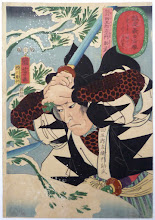I've been thinking a bit about how a lot of myths and sagas are organized, and how that compares to a lot of modern fantasy fiction. These ideas are still fairly undeveloped, but I'll get my early thoughts down here, and hopefully expand on them when I've got time.
There are several 'layers of the fantastic' in a lot of myths.
Mythic: stories of the gods themselves, full of monsters, magic, and not necessarily happening in the physical universe as we know it.
Legendary: stories of demi-gods and heroes, also full of monsters, magic, and the unusual, but happening in the physical world for the most part.
Heroic: stories of heroes, with some lesser amounts of monsters and magic, happening in the physical world, and often semi-historical.
Mundane: stories of normal folks in semi-heroic situations, very little magic/few monsters, happening in a semi-historical or fully historical setting.
Classical Greek mythology, for example, tends to be organized (at least in modern collections we have to read) in the order above. You get the tales of the beginning of the universe, the pantheons of gods, naming myths, etc. Then you get the hero myths of Perseus, Theseus, Heracles, etc. which are full of adventures and monsters and magic. Then you get stories like the Trojan War and Odyssey which have their fantastic bits, but take place in a more 'verisimilitudinous' world. You don't get much 'mundane' in the mythology books, but there are things like the Battle of Thermopylae that while historical, get a more heroic gloss.
The Norse Volsungasaga (Saga of the Volsungs) follows a similar pattern all within its one text. It starts with the story of how Andvari cursed the gold (all about Odin, Loki, Thor and a bunch of dwarves). Then you get Sigmund's story, which while mortal is still heavily fantastic and somewhat surreal. Next we get Sigurd's slaying of Fafnir (and Regin) which removes most of the fantastic from the story. Then Sigurd gets thrown in with the (semi-)historical Burgundian kings Gunnar and Hogni, plus one valkyrie who doesn't act much like one once she's rescued from the flames. Finally, we get the tale of Gudrun's revenge against Atli (Atilla the Hun), which is pretty much devoid of anything supernatural.
In the Bible, most of this progression happens just in Genesis.
Not every myth or saga follows this, though. For example, Journey to the West begins heavily mythical, with the origin of Monkey and his revolt in Heaven, then suddenly switches to semi-historical to introduce Tang Sanzang and the journey to bring back the sutras (based on a historical event), but once Sanzang gets Monkey, Pig and Friar Sand and they head out into the wilderness, we return to a heavily mythological world.
What I find interesting, though, is that a lot of modern fantasy goes in the opposite direction. There are so many stories of the 'man out of time' or as James M. calls it, the Stranger, where people from the Mundane world get thrown into a world of Heroics, Legends or even Myths.
The Pevensie kids go from England to Narnia. John Carter goes from Arizona to Mars. Richard Rahl (whatever his name was in the first book, before he learned he was the BBEG's son) goes from the Riverlands into the Midlands. Dorothy goes from Kansas to Oz. Holger Carlson from WWII Denmark to mythic Caroligian France.
Obviously, from a literary standpoint this makes it easy on the reader. The author has perfectly good reasons IN THE STORY to give the reader all the exposition they need to understand the fantasy realm.
Other fantasy works pretty much stick with the level of fantasy in which they start. Hyboria is just as it is in "The God in the Bowl" and in "The Hour of the Dragon." Middle Earth moves from a Legendary age to a mere Heroic age (we assume) at the end of Lord of the Rings, but almost all of the narrative in the Hobbit and LotR take place in that Legendary realm. It's really only in the Appendices that we see much of that 'lesser' age after the elves depart.
Anyway, not completely sure where I'm going with this. It's mostly just food for later thought. Still, if this seems useful or useless to you, or if you've got any other levels I've missed, or whatever, feel free to chime in on the comments.
Friday Fantasy: Return of the Green Death
5 hours ago






I think you can also break some stories down according to component (people, places, magic and monsters.) For example, some Celtic faerie stories are about Heroic or often even Mundane people who stumble into a full-on Mythic environment.
ReplyDeleteI think what I prefer and seek to emulate is Mundane-to-Heroic people, Legendary magic and monsters, and Mythic places.
The point about exposition is well taken - I think also in RPGs the value of one's own character being 'relatable' is often undervalued, for reasons not so different from machismo. Storytellers include a character like the audience to anchor the alien parts, as much as to cue exposition. Most of all as a player I want to know how much I'm supposed to understand about the world, and the higher you go up the mythic scale the more different and metaphorical the rules of the world become, so the less certain I for one get about what's appropriate/allowable.
ReplyDelete